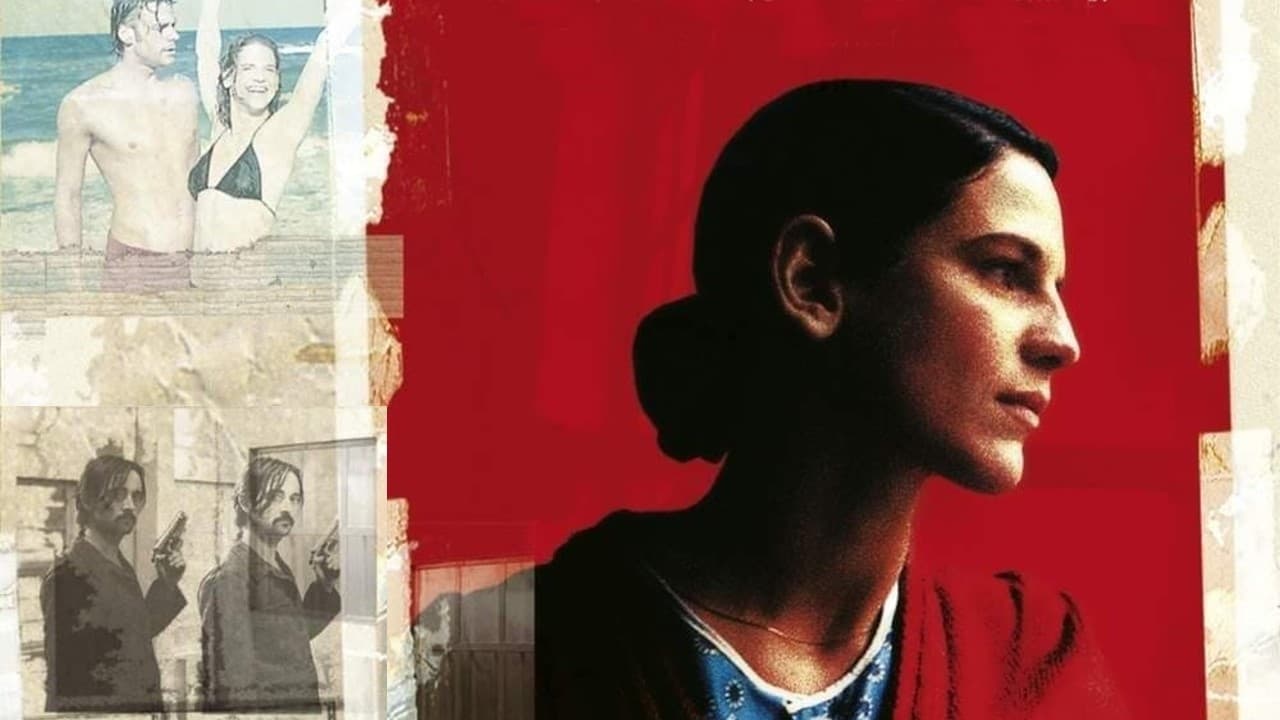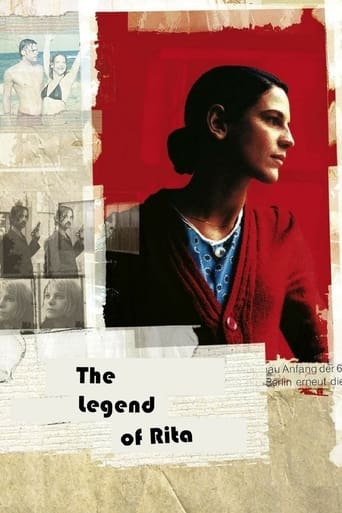

The Legend of Rita, this movie's English-language title, is not as hokey as it initially sounds. "Legend" was the term used by the East German Secret Police (the Stazi) for the cover stories created to disguise the identities of West German terrorists who had been secretly granted asylum in the East. The German title, Die Stille nach dem Schuss (literally The Stillness after Rapid Action), is a German phrase that sounds fine in its original language but is too abstract for colloquial translation of a film that is, among other things, an effective thriller."Schuss" in the original title refers to the bank robberies and killings shown at the beginning of the film and "Stille" to the subsequent life, east of the Berlin Wall, of Rita Vogt, a member of a terrorist cell determined to change the world by violent action. She is a fictitious character, a composite of several real people. Eleven such individuals from West Germany, did, in fact, find refuge in the East, but only on condition that they live peacefully as ordinary workers and have no contact with one another. Director Volker Schlöndorff says, in a lengthy audio commentary that accompanies silent images from the film on its Kino Video DVD, that "the episodes are authentic but the characters are somewhat fictitious." The "somewhat fictitious" Rita is assigned two identities during her years in East Germany. Initially, she works in a textile factory and develops a passionate friendship with an East German woman. Then, following her identification by another worker, she is given a new legend and becomes a child care worker for a state agency. In this identity, she falls in love with an engineer who has been assigned to work for five years in Moscow. They want to marry and have children but the Stazi doesn't want her going to Moscow out of fear of discovery by the Soviets. Rita violates her orders from the Stazi and reveals her identify to her lover. His astonishment and rejection make their separation easier.Things change for Rita with the fall of the Berlin Wall and approaching German reunification. She finds herself, alone among her workplace associates, regretting the demise of a country that, however imperfectly, tried to make human relationships more important than economic success. Once again, she is a fugitive terrorist. Preferring tragedy to capture or a life in hiding, she steals a policeman's motorcycle, drives it through a border post, and is shot and killed by a guard.The reason for East Germany's granting of asylum to West German terrorists is not entirely clear, either in the film or in real life. The closest the film comes to an explanation occurs when the members of the Red Army cell meet with their Stazi minder for a bratwurst barbecue at a pleasant rural villa. East Germany has signed the Helsinki Convention against harboring terrorists and has no interest in supporting what Lenin called "infantile Leftism." Cell members are given a choice of transportation to a third world country or remaining in East Germany. Individuals make different choices and kiss one another good bye. A Stazi executive at the barbecue suggests that a longing for lost revolutionary romanticism underlies the East Germany policy.Another aspect of the film is its portrayal of everyday life in East Germany. It does this more completely than either Good Bye Lenin (2003) or The Lives of Others (2006) although these are, in many respects, excellent movies. To Western eyes, the results are surprising. Not everything is East Germany is drab and gray. The Stazi is ubiquitous but not omnipotent. Rita wears a sexy bikini when supervising children at a Baltic beach and no one thinks anything of it. People have a variety of opinions about many different subjects. According to Schlöndorff's commentary, West German viewers found the portrayal of East German life insufficiently harsh but former Easterners thought it exceptionally accurate.I seldom give movies 10 ratings but, for The Legend of Rita, I can find nothing that should have been done differently. Both Schlöndorff and Wolfgang Kohlhaase are superb scriptwriters. Bibiana Beglau plays Rita and Martin Wuttke is Erwin Hull, Rita's sympathetic Stazi minder. All of the actors are excellent. The cinematography and editing are consistently tight and competent. From what I can see, the film has no weak links. I had not previously heard of it and got its DVD, almost by accident, from a public library. Wonderful discoveries are possible.
... View MoreOkay, so I was really primed to love "The Legend of Rita". And, yes, no surprise, I love this movie. Here's why: First of all, it's an objective film about the European left in all its shapes and sizes. Rita is a member of a radical group of German urban guerrillas somewhat based on the Baader-Meinhoff gang and somewhat based on the Hash Rebels. She kills a police officer, but unlike Western mainstream cinema, we still sympathize with her and identify with her struggle. She is aided by the East German Stasi, who see as normal people doing a job they believe in, rather than as the Stalinistic secret police we're told to believe they were. We see East Berlin as a difficult place to live. But not as the colorless, endless ghetto with bread lines that books and films have also told us. It's an objective film.Second of all, it's a film where the main character is a woman driven by her ideological convictions AS WELL AS her loves and desires. If Hollywood made the film, unrequited love or some sort of sexual frustration would drive her. Her political convictions and dedication to leftist revolution are what give her strong character and is not her Achilles heel.The film follows Rita as a young member of a radical group in '70s Berlin. While traveling back from Lebanon, a series of events leads her to make friends with the Stasi who aid her and her companions throughout their misadventures. After killing a cop during a police chase, she creates a new identity and lives a normal life in the East.From there the film follows her life and the end of the Cold War (World War III). I know most of the world was celebrating Glasnost. But to me, it felt like such a huge failure. Now, I may be an anarchist and I may have the same problems many of you had with the Soviet Union. But the fall of communism still felt like defeat. And for revolutionaries around the world, including people like Rita many of whom were turned over to the invading right wing bureaucrats, it was a palpable defeat.
... View MoreRita's story is one of the most moving films I have seen in a great long while. It reveals some of the true story of terrorism through the life of one West Germany's notorious RAF terrorists.The world is at war with itself. We live in a loveless plutocracy of materialism. Once you have understood the spiritual bankruptcy of the paradigm you cease to exist in Western society as a citizen and are horrified everyday by the venality and corruption and callousness on each side.A select few decide to do something about it. Rita is one of a group of ten in West Germany. They do what they can as long as they can with GDR (East German) support. Rita finally loses the vocation and wishes for a normal life - as a working class person - in GDR. They give it to her.She is happy, but cannot escape her past. She loves twice as a civilian and loses everything on both occasions as a consequence of her former identity.The collapse of the wall ends any possibility of a conventional life for her. Unlike her fellow GDR citizens, Rita knew the consequences of reunification and the destruction it would wreak on East German communities and lives. Her speech to her jubilant co-workers a passionate and prophetic plea. But when Rita sees another former comrade arrested she must make a run for it.The final shot is tragic and beautiful of the collapse of a motorcyle on a rainstrewn country road.The image of Rita and her struggle for a better world will stay with me for a long, long time. Thank you to Wolfgang Kohlhaase and Volker Schlöndorff for telling honestly a story rarely told. With the events of September 2001, it may be a decade before anyone can make such a film on this subject.The images are beautiful, if relatively conventional. Much of the art house crowd to whom this movie plays in North America require more avant-garde techniques to satisfy their insatiable cravings for the recondite, difficult and impenetrable. Frankly the story is better told well in the conventional language of good cinematography. The fine closeups are particularly notable.Good performances all around, especially by Bibianne Beglau in the title role. Nadja Uhl is a revelation as Tatjana, a beautiful self-destructive alcoholic of uncertain sexuality but strong friendship. Jenny Schilly is excellent in the small role of Friederike, Rita's comrade in arms. Harald Schrott has a fantastic intensity as the lead revolutionary Andi. One of the key personalities in the film is their Stasi handler Erwinn. Sadly, most of the time Martin Wuttke's performance is too ironic by half. His Stasi sidekick is much better played by an actor whose name escapes me.
... View MoreMaybe it's the cultural specificity of the piece, but somehow Volker Schlondorff's "The Legends of Rita" fails to hit the right emotional chords, where essentially the film's humanism-over-politics thematics want to evoke in the audience. Don't get me wrong, "Rita" is an excellently crafted film, subtle and never forceful. The film succeeds above and beyond expectations in its depiction of the latter years of the GDR, portraying an ideologically bankrupt nation whose environments and inhabitants seem to be caught in a state of limbo. Perhaps Schlondorff's acquiring of the former DEFA (and UFA before it) Babelsburg studios is the main reason for the authenticity of his vision of the former East. As well, this is a departure from the realm of fantasy that Schlondorff had probed history within in such works as "The Ogre" and "The Tin Drum." Instead, as with Bertolucci's "Besieged," the director has returned to his roots in filmmaking and provided a once-again fresh, verité aesthetic. This could very well be a companion piece to "The Lost Honour of Katharina Blum," although, as I mentioned earlier, the emotions fall flat here, failing to deliver an ultimate, devastating "punch."
... View More